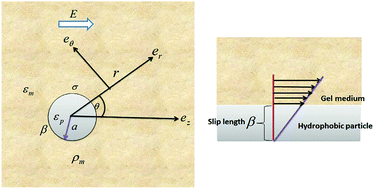A simplified model for gel electrophoresis of a hydrophobic rigid colloid
Abstract
Electrophoresis of a charged dielectric hydrophobic colloid embedded in a charged hydrogel medium is addressed. A slip velocity condition at the particle surface is considered. The characteristic of the gel electrophoresis is different compared with the free-solution electrophoresis due to the presence of immobile charges of the gel medium, which induces a strong background electroosmotic flow and modifies the Debye layer of the colloid. The gel electrophoresis of the dielectric hydrophobic charged colloid is made based on first-order perturbation analysis. A closed form solution involving simple exponential integrals for the mobility is derived, which reduces to several existing mobility expressions under limiting conditions such as for the gel electrophoresis of hydrophilic particles and a hydrophobic colloid in free-solution electrophoresis. We find that the mobility reversal is achieved by varying the Debye length or gel permeability. For the present first-order perturbation analysis, unlike free-solution electrophoresis, the particle dielectric permittivity is found to influence the mobility. One of the intriguing features of the present study is the derivation of the simplified mobility expression, which can be easily computed for a given set of parameter values.



 Please wait while we load your content...
Please wait while we load your content...